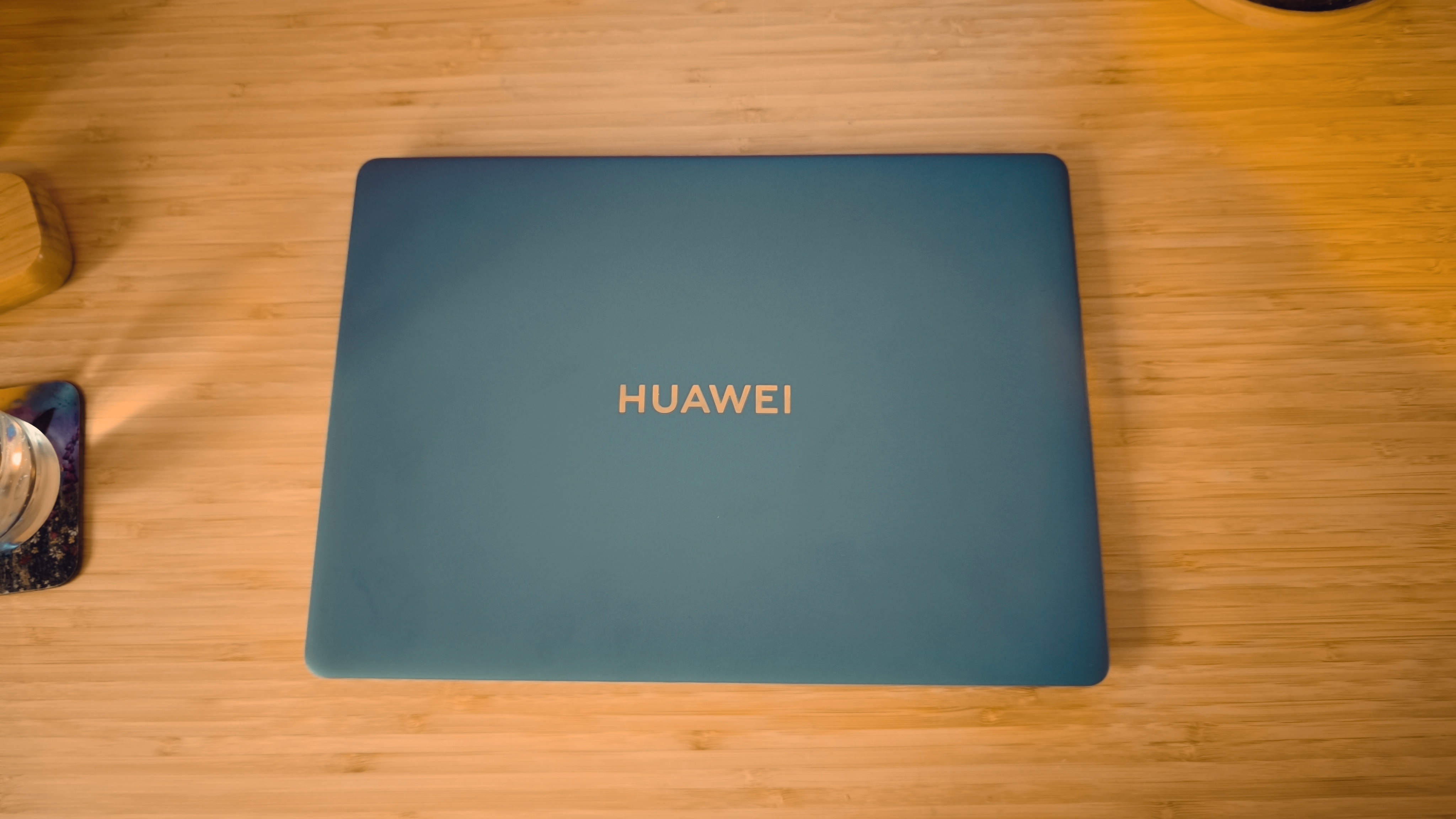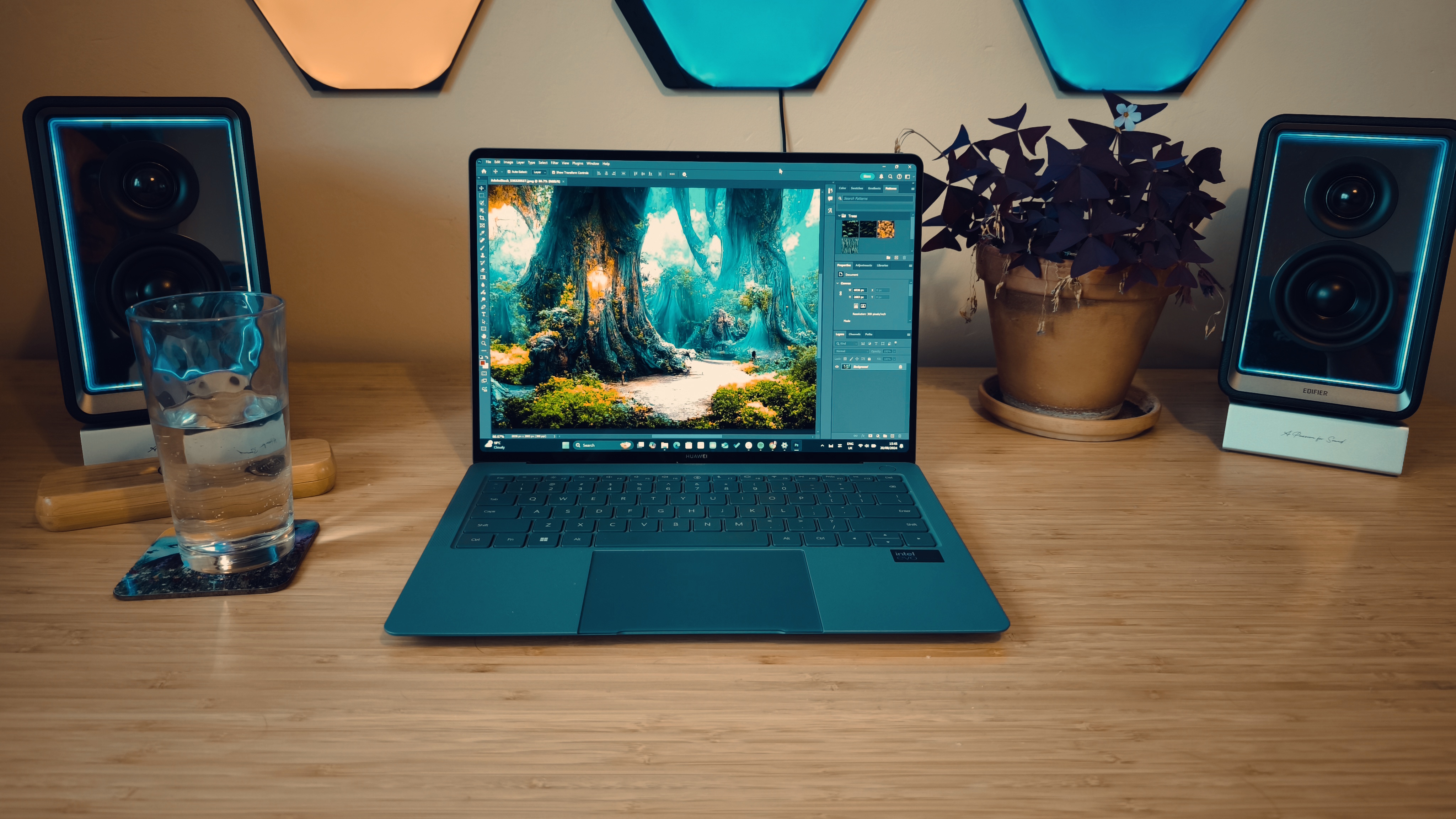Our Verdict
The Huawei Matebook X Pro may be my favourite laptop I've tested this year. While integrated graphics limit its 3D (and gaming) potential a fair bit, all the other internals are powerful enough to make any other job a proverbial breeze. It's ridiculously lightweight, looks gorgeous and the OLED touchscreen is a delight to use and look at. The only downside is a lack of ports...
For
- Super lightweight
- Fantastic performance
- Looks beautiful
Against
- Fairly pricey
- Integrated graphics
- Very few ports
Why you can trust Creative Bloq
The Huawei Matebook X Pro has featured before on Creative Bloq, back in 2022, when we were hugely impressed by its looks, performance and ease of use.
Fast-forward to today, and I find myself testing its successor, which is now Intel Core Ultra 7-powered, AI-boosted and equipped with Intel's new generation of integrated graphics, Intel Arc.
The previous model was already a great laptop for many different uses, including hybrid workers, photo editors and those looking for a lightweight machine to carry everywhere, among others.
And after having the new model as my everyday laptop for over a month, I'm happy to confirm it's just gotten better.

Huawei Matebook X Pro (2024): Key specifications
CPU: | Intel Core Ultra 9 185H |
Graphics: | Intel Arc Graphics |
Memory: | 32GB |
Screen size: | 14.2in OLED touchscreen |
Resolution: | 3120 x 2080 (3:2) |
Refresh rate: | 120Hz max |
Colour gamut (measured): | 100% sRGB, 94% AdobeRGB, 100% P3, 1000 nits |
Storage: | 2TB SSD |
Connectivity: | 2x USB-C 4.0, 1x Thunderbolt 4 (all support power delivery and DisplayPort) |
Dimensions: | 310 x 222 x 13.5 mm |
Weight: | 980g |

Design and build
What I noticed first when opening up the Huawei Matebook X Pro was just how pretty it is. This is unfortunately a rare occurrence with Windows laptops, which mostly come in either boring silver or boring black. Not this one. This one is presented in a matte, fine-coated 'Morandi Blue', a particularly pleasant shade of pale blue all over, including the trackpad and keyboard, which are just a hint darker shade of blue to stand out from the body.
It's also a different shape to most laptops today, with the screen shaped in a tall-boi 3:2 ratio, making for considerably more vertical space than I'm used to on a laptop, maximising the potential of the compact 14.2-inch OLED display.
It's a touchscreen too, with a ten-point touch functionality like its predecessor that's so responsive it should come with an addiction disclaimer.
And somehow, through some engineering magic, Huawei has managed to pack twice the power and storage of its 2022 predecessor in here while cutting almost a quarter of a kilogram off the weight. It's now 980 grams, lighter than the lightest laptop I'd ever used before this (the ASUS Zenbook S 13) and only a fraction heavier than an iPad Pro with a keyboard attached.
If first impression is everything, we have a perfect laptop right here.
But then I look at the sides, and found one area where weight-saving was clearly (and maybe cleverly) achieved; the ports. That is, there's hardly any of them. You get three USB-C ports, and that's it. That's the whole list. One of those you'll need to use for the power cable and if you want to use an external keyboard, mouse and monitor, you better hope at least one of those is wireless, lest you need to invest in a dock on top of an already expensive laptop. Thankfully, every port is a high-speed USB 4 or Thunderbolt, supporting power delivery and DisplayPort, so there's that, at least.

Features
Fire it up and you find some wizardry on the inside too. Equipped with the new AI-boosted Intel Core Ultra processor (you can either get the Ultra 7 155H or Ultra 9 185H, I had the latter for this test) and 32GB of LDDR5 RAM, with either 1 or 2TB SSD on board, the 1000-nit screen lits up immediately, with startup and app launch almost instantaneous.
We get Wi-Fi 6E and Bluetooth 5.3 compatibility, meaning all connections to the laptop are as fast as you can reasonably expect from a consumer machine, and the HD webcam supports Windows Hello, too. After setting that up, all I had to do to get started in the morning was to smash the power button/fingerprint reader above the responsive chiclet keyboard and glance at the camera, and a few seconds later I was automagically logged in and ready to start working.
The one sacrifice made in the quest for ultimate lightness is that the graphics are integrated only, but as I've found out, Intel's new Arc Graphics can actually do a whole lot more than the previous Iris Xe was capable of. You may want to steer clear of big 3D rendering jobs or taking on massive architecture contracts if all you have is this Matebook, but I used Photoshop, video-editing software and even ran some lighter games without any issues. Yes, the fan gets a bit anxious, and it got a bit hot to the touch when playing games like Cities Skylines 2, but nothing to worry about.
The trackpad is an evolution of the one in the 2022 model, slightly bigger but equipped with the same intuitive touch-control feature set we liked so much about the previous model.
The webcam has also been improved since last time, with a Full HD one fitted here, and I found it responded well to lighting changes, subpar home office lighting and had very decent focus and sharpness to the image. The quad-mic setup also helped my voice carry well, even when moving around, while the six-speaker array gave me clear voices coming the other way. For music, the depth is not great, but a whole lot better than in most laptop speakers, I will admit. If you're an audiophile though, you probably already have a pair of class headphones or good external speakers, and I recommend you stick with them.

Benchmark scoring
Geekbench 6 | Row 0 - Cell 1 |
CPU single-core: | 2,345 |
CPU multi-core: | 13,487 |
GPU OpenCL: | 36,288 |
Cinebench 2024 | Row 4 - Cell 1 |
Single-core: | 102 |
Multi-core: | 820 |
PCMark 10 | Row 7 - Cell 1 |
Total: | 6,972 |
Essentials: | 11,050 |
Productivity: | 8,276 |
Digital Content Creation: | 10,056 |
3D Mark: | Time Spy: 4,082 @ 24.5fps, Fire Strike: 8,727 @ 45.9fps, Night Raid: 28,800 @ 212.8fps |
Handbrake: | 5m 8s @62.4fps |
PugetBench Photoshop: | 6,750 |

Performance
Benchmarking tests were hugely impressive, especially for such a compact laptop with integrated graphics. To put the numbers above in context, let's start with the Geekbench tests, multi-core CPU scores put it ahead of the new ASUS Zenbook 14 OLED and the ASUS Vivobook 16 Pro, and only a hair behind the extremely capable HP Omen Transcend 14 gaming laptop, and the GPU score also outdoes my previous integrated-graphics record holder, again the Zenbook 14 OLED.
It was a similar story in Cinebench, which tests the computer's ability to handle 3D-related tasks (Cinebench is from Maxon, the maker of Cinema 4D), where the Matebook X Pro was pretty much on par with the highly touted Zenbook, and not at all far behind the Omen and the Acer Predator Helios 16 in CPU tests. Unfortunately, the Arc Graphics wouldn't run the GPU test in Cinebench, so that confirms this laptop, like any laptop without a discrete graphics card, is not suitable for heavy 3D processing, but image rendering and computational power for flat images is more than plentiful.
The PugetBench Photoshop confirms that last point, as the Huawei machine actually outdoes the Omen, so this is an ideal laptop for any travelling photo editor. The Digital Content Creation score in PC Mark 10, which tests the computer's all-around work capabilities, also outperforms the Omen, marking it out again as an excellent option for content creators on the move (seriously, it's so light you guys). The Handbrake video encoding test, which transcodes a 4K animation to a Full HD video, further confirmed this with an impressive rendering time of just over 5 minutes, less than half a minute slower than the Vivobook Pro 16, which has a 40-series NVIDIA graphics card on board.
At that point I decided to run 3D Mark gaming benchmarks on it, despite it only having integrated graphics, because why the heck not.
And to my entire lack of surprise, the Time Spy test (which tests its capacity to run AAA-style games) came out at a pedestrian 25 frames per second, while the Fire Strike test (slightly less demanding) got it closer to performance territory. Meanwhile, the Night Raid test (for less visually demanding games) scored a sensational 212 frames per second, so you can run any light game on this machine and not notice any difference between this and a bespoke gaming laptop.

Price
As is well documented, Huawei products aren't widely sold in the US due to the ongoing dispute between the company's Chinese owners and the US authorities, but the Ultra 7-specced model can be had for £1,499 in the UK (and it's widely and readily available throughout most of the rest of the world). It's a lot of money for a little laptop, yes, but it's only a little laptop on the outside, because as I've detailed, it's mighty on the inside.
Who is it for?

The Huawei Matebook X Pro (2024) is a gorgeous-looking laptop that will suit any content creator perfectly, as well as anyone working in digital art or photo editing, especially if they travel around a lot, because it's ridiculously light and easy to carry around. Its integrated Arc Graphics prevent it from performing difficult 3D or big visual rendering jobs, but you can play (light to medium) games on it and the bright, colour-accurate touchscreen supports a stylus for digital artists.
Buy it if:
- You are looking for the ultimate lightweight laptop
- You want a bright touchscreen
- You want lots of computer power and versatility
Don't buy it if:
- You need dedicated graphics processing
- You want to play AAA games
- Your budget doesn't stretch into four figures

Also consider
Super lightweight, super good-looking and a super-performer for its price, this is a hybrid worker's dream and a fair bit cheaper than the Matebook X Pro.
The lightweight MacBook is still a great laptop, but its lower price is reflected in lower performance than you'll find on-board the Huawei. Also, no touchscreen.
If you need that extra graphics prowess, the HP Omen has similar CPU performance plus a 40-series graphics card to handle 3D modelling (and Black Myth: Wukong after work) for only a little bit more money.
out of 10
The Huawei Matebook X Pro may be my favourite laptop I've tested this year. While integrated graphics limit its 3D (and gaming) potential a fair bit, all the other internals are powerful enough to make any other job a proverbial breeze. It's ridiculously lightweight, looks gorgeous and the OLED touchscreen is a delight to use and look at. The only downside is a lack of ports...

Erlingur is the Tech Reviews Editor on Creative Bloq. Having worked on magazines devoted to Photoshop, films, history, and science for over 15 years, as well as working on Digital Camera World and Top Ten Reviews in more recent times, Erlingur has developed a passion for finding tech that helps people do their job, whatever it may be. He loves putting things to the test and seeing if they're all hyped up to be, to make sure people are getting what they're promised. Still can't get his wifi-only printer to connect to his computer.




